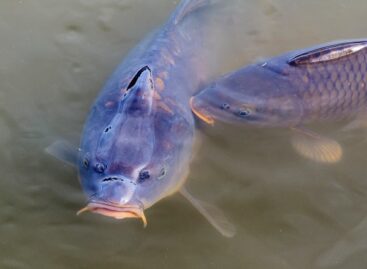Supply is already given

Ákos Bősze
HoReCa
business development executive
METRO
The role of fish in our culinary culture has changed fundamentally over the past decade, emphasises Ákos Bősze, METRO’s HoReCa business development executive. Today it isn’t a seasonal specialty anymore, but a year-round staple in the catering industry. METRO’s selection of fresh fish includes more than seventy varieties, many of which are processed locally to guarantee freshness. The frozen product range is also expanding, as this segment accounts for the largest share of the catering industry in terms of volume. The market is characterised by stable demand throughout the year.

Fresh fish and seafood mainly appear on the menu of premium restaurants
This article is available for reading in Trade magazin 2025/11.
Alternatives

József Géczi
owner-CEO
FJORDIN
We learn from József Géczi, owner and CEO of FJORDIN Kft. that they offer a wide and diverse selection of frozen fish and seafood products. Their product range covers the needs of the catering industry in terms of type, level of processing and price. The company works with a consciously diversified supplier base and stock several brands of the same products, so that partners can choose according to their needs. They sell more than 70 products made from frozen seafood alone. Fish used to be seasonal, but freezing and the availability of farmed species have now almost eliminated this limitation.
Continuous development

Krisztina Sinkó
head of marketing
BAHAMAS
BAHAMAS Kft. offers an extremely wide range of products, stresses head of marketing Krisztina Sinkó. They sell more than twenty types of freshwater fish at various levels of processing and price points, but the selection of saltwater fish is just as rich. Seafood includes octopus, various shellfish, crabs and seafood mixes. The level of processing ranges from whole fish to portioned, filleted and even breaded products. Unfortunately, domestic fish consumption is still not outstanding, but it is constantly improving. Fish is now considered a year-round product that can be found on the menu of most restaurants throughout the year.
Demand for ready-to-cook products
In addition to classic freshwater fish, seafood and shellfish are more and more popular in gastronomy, says Ákos Bősze. Italian, Asian and sushi restaurants in particular work with a large variety of species. Fish has become a symbol of gastronomic diversity, belonging not only to festive occasions but also to everyday meals. There is a growing demand for convenient, ready-to-cook products that allow for quick and efficient preparation. METRO contributes to this progress via the METRO Gastro Academy, where they organise fish-themed training courses.
Development directions
Consumption habits are shaped by trends and the offering of a popular restaurant can easily make certain fish species popular, which then become permanent fixtures – points out József Géczi. New farmed species regularly bring something new to the table, often replacing a species with limited fishing rights with a similar, but more readily available one. In addition to the classic favourites – salmon, cod, tuna, butterfish and mackerel – sardines and mahi-mahi are also increasingly popular. As regards processing, the catering industry prefers filleted, portioned products that don’t require preparation. Development work is clearly moving towards convenience products.

Hake, carp, or pangasius are accessible to many people
Consumption habits
Hungary doesn’t belong to the group of countries where the level of fish consumption is high, argues Krisztina Sinkó. This is why several measures have been taken in recent years, in order to encourage fish consumption, e.g. cutting the VAT on fish products to 5% and introducing one or two fish days a week in mass catering. Consumption habits are also changing: there is a growing demand for boneless, ready-to-cook and imported products. The most popular types of fish include hake, salmon, trout, perch, pike, tuna, carp, catfish, African catfish, pangasius, tilapia and cod. In catering fully processed, filleted, cleaned and portioned products are preferred.
Hungary’s aquaculture
Over the past decade fish production has grown by 3.1% per year on average. In 2022 more than 18,700 tonnes of fish was bred on nearly 27,000 hectares, with the participation of 377 companies. Carp dominates with an 82% share, but with the spread of intensive technologies Hungary has also become Europe’s largest producer of African catfish. The structure of the processing industry is fragmented: typically smaller companies operate, often carrying out both breeding and processing. Approximately 7,000 tonnes of processed products are made in a year. Domestic consumption has grown a bit in recent years, reaching 6.7kg per capita in 2022, which is still only a quarter of the EU average.
Education and consumption
Hungary has no sea fishing fleet due to its lack of sea borders and fishing in natural waters has been banned since 2016. Domestic fish consumption is now primarily supplied by aquaculture, which is based on freshwater species such as carp, catfish, trout and grass carp. One of the biggest challenges that the domestic market is facing is inflation and rising input costs. Consumers are becoming increasingly price-sensitive, while quality and origin are also important. Education and marketing are important focus areas, as most people don’t know how to prepare fish or its health benefits.
Related news
There will be no shortage of high-quality Hungarian fish, according to professional organizations
🎧 Hallgasd a cikket: Lejátszás Szünet Folytatás Leállítás Nyelv: Auto…
Read more >Despite the drought, there will be no shortage of high-quality Hungarian fish
🎧 Hallgasd a cikket: Lejátszás Szünet Folytatás Leállítás Nyelv: Auto…
Read more >Ice cream as a season-extending product
🎧 Hallgasd a cikket: Lejátszás Szünet Folytatás Leállítás Nyelv: Auto…
Read more >Related news
(HU) Önáltató sörisszák – A nap képe
🎧 Hallgasd a cikket: Lejátszás Szünet Folytatás Leállítás Nyelv: Auto…
Read more >(HU) A nap mondása
🎧 Hallgasd a cikket: Lejátszás Szünet Folytatás Leállítás Nyelv: Auto…
Read more >MBH Analysis Center: Hungarian tourism is soaring – further growth is expected in the hotel market
🎧 Hallgasd a cikket: Lejátszás Szünet Folytatás Leállítás Nyelv: Auto…
Read more >






